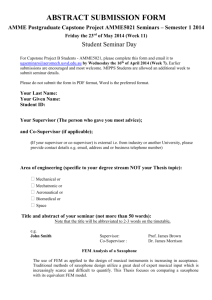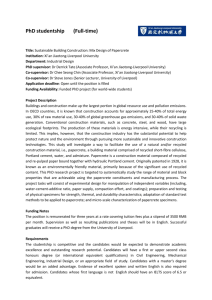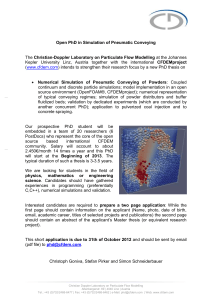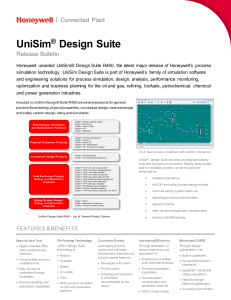Projects for Professor Sigurd Skogestad. Autumn 2009
advertisement
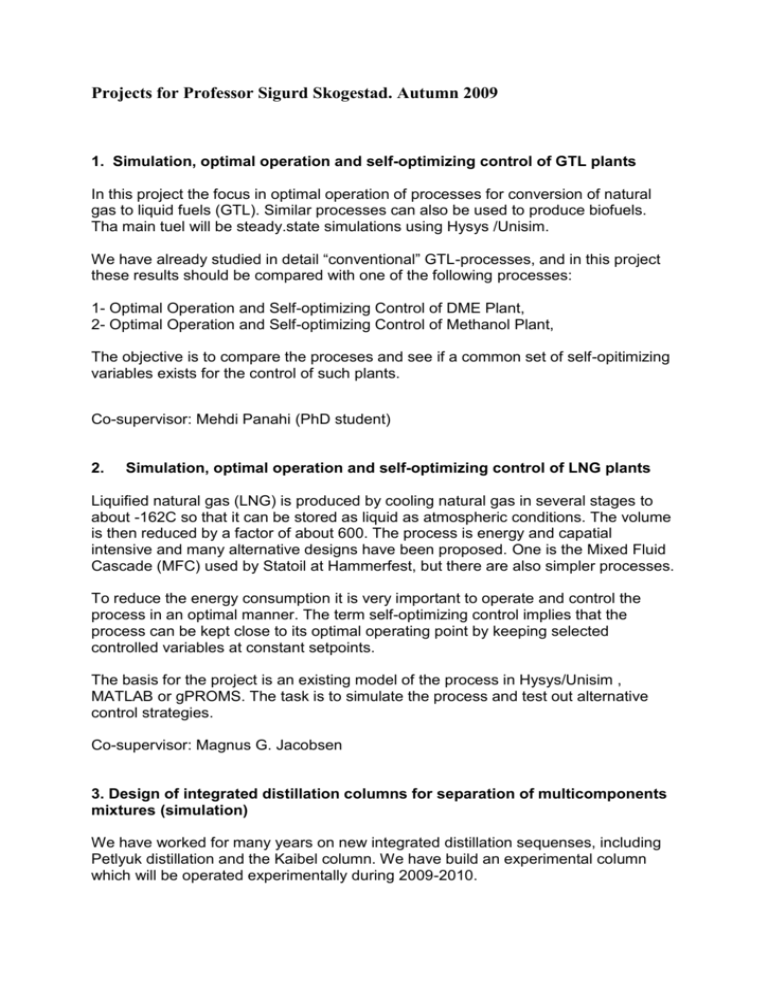
Projects for Professor Sigurd Skogestad. Autumn 2009 1. Simulation, optimal operation and self-optimizing control of GTL plants In this project the focus in optimal operation of processes for conversion of natural gas to liquid fuels (GTL). Similar processes can also be used to produce biofuels. Tha main tuel will be steady.state simulations using Hysys /Unisim. We have already studied in detail “conventional” GTL-processes, and in this project these results should be compared with one of the following processes: 1- Optimal Operation and Self-optimizing Control of DME Plant, 2- Optimal Operation and Self-optimizing Control of Methanol Plant, The objective is to compare the proceses and see if a common set of self-opitimizing variables exists for the control of such plants. Co-supervisor: Mehdi Panahi (PhD student) 2. Simulation, optimal operation and self-optimizing control of LNG plants Liquified natural gas (LNG) is produced by cooling natural gas in several stages to about -162C so that it can be stored as liquid as atmospheric conditions. The volume is then reduced by a factor of about 600. The process is energy and capatial intensive and many alternative designs have been proposed. One is the Mixed Fluid Cascade (MFC) used by Statoil at Hammerfest, but there are also simpler processes. To reduce the energy consumption it is very important to operate and control the process in an optimal manner. The term self-optimizing control implies that the process can be kept close to its optimal operating point by keeping selected controlled variables at constant setpoints. The basis for the project is an existing model of the process in Hysys/Unisim , MATLAB or gPROMS. The task is to simulate the process and test out alternative control strategies. Co-supervisor: Magnus G. Jacobsen 3. Design of integrated distillation columns for separation of multicomponents mixtures (simulation) We have worked for many years on new integrated distillation sequenses, including Petlyuk distillation and the Kaibel column. We have build an experimental column which will be operated experimentally during 2009-2010. In this project, the focus will be on design, whereas two other projects will focus on operation and control. More specifically, the goal of this project is to look for the optimized thermally coupled distillation sequences for multi-component separations. A rigorous model is developed in UNISIM and MATLAB or GAMS will be used for the optimization. So, the capabilities of both softwares are used at the same time. Different alternatives are simulated in UNISIM and then the best option should be selected considering the energy savings through a proper optimization of the interconnecting streams. Co-supervisor: PhD student + Ivar J. Halvorsen (SINTEF) 4. Control and operation of Kaibel distillation column (simulation). Co-supervisor: PhD student + Ivar J. Halvorsen (SINTEF) 5. Control and operation of Kaibel distillation column (experiment). Co-supervisor: PhD student + Ivar J. Halvorsen (SINTEF) Petlyuk-kolonner tas i stigende bruk i verden pga. mulighetene for reduksjoner i energi og investering. Vi har en flott eksperimentell rigg i hall C. Foreløpig kjører vi alkoholer, men vi planlegger et samarbeid med Statoil på kjøring av C5-C6 blandinger. Det arbeides også med å legge inn automatisk regulering av dampsplitten som vil være helt nytt når det gjelder denne type kolonner . Medveileder: Ivar J. Halvorsen, SINTEF 6. Explicit MPC Co-supervisor: PhD student Henrik Manum The model predictive control (MPC) problem consists of minimizing a cost function subject to a model of the plant and operating constraints. For systems with a small number of states the model predictive control (MPC) problem may be solved off-line giving an explicit control law as a function of the present state; see the recent survey by Alessio and Bemporad, 2008. The solution is such that the state space will be divided into regions with different optimal state feedback laws. A key issue in implementation of an explicit MPC controller is to identify the region that contains the current state. Previous work on this topic includes utilization of a binary search three throughout the regions. If not all states are measured a state observer needs to be included in the loop. The main draw-back of the explicit solution is that exponential growth of complexity (=number of regions that need to be stored) has been observed when the statedimension and input horizon are increased. Hence approximative solutions have been developed in numerous papers. Even though a lot of literature exists, there is no survey available of these methods. In this project we want to make an overview over the available methods and make clear guidelines for which method is best suited for a given plant and objective function. The student(s) should have a good interest in programming, especially Matlab, but also some knowledge of java may be useful. We want to make a data-base of available methods and examples and perhaps also make a web-page where users can upload code and test their algorithms. We have a good cooperation with one of the leading groups in this field, namely Institute for Automation at ETH-Zürich, and we also have contacts with other groups in the area. References A. Alessio and A. Bemporad: "A survey on explicit model predictive control," In Proc. Int. Workshop on Assessment and Future Directions of Nonlinear Model Predictive Control, Pavia, Italy, 2008 The objective of the project is to test out these ideas by simulation and to propose and test out extensions. 7. Dynamic simulation of alternative control strategies Co-supervsior: PhD student Ramprasad Yelshuru The objective is to simulate and compare alternative base (regulatory) control structures on some case studies using dynamic simulation (Hysys/Unisim). Links to desciptions of the software: http://hpsweb.honeywell.com/Cultures/enUS/Products/ControlApplications/AdvancedControlOptimization/ProfitController/defau lt.htm http://hpsweb.honeywell.com/Cultures/enUS/Products/ControlApplications/Simulation/default.htm” 8. Self-optimizing control of batch processes Co-supervisor: PhD student Håkon Dahl-Olsen Based on a dynamic model (in Matlab or gProms) of a batch reactor or batch distillation column, the task is to test out alternative self-optimizing control strategies. The objective is to minimize the batch time 9. Dynamic Model and Control of Heat Exchanger Networks for District Heating Co-supervisor: PhD student Johannes Jäschke In Trondheim there is a district heating network for hot water based on the Tiller incineration plant for burning waste, and in Oslo there are similar plants. It is possible to save energy by improving the operation and control of such systems. This will be a continuation of a successful earlier project in cooperation with Helge Mordt at Prediktor (Fredrikstad) who has been working with the Oslo plant. The project will use Matlab/Simulink as a tool for modelling and simulation. Depending on the interest of the student, three possible projects are suggested 9.1 Modelling of district heating network 9.2 Model predictive control of district heating network. 9.3 Self-optimizing control of polynomial systems 10. Simple rules for retuning of control loops Most PID tuning rules, for example the SIMC tuning rules, assume that one has available a simple process model obtained from open-loop experiments. The objective is to extend the tuning rules to the closed-loop case where a controller is already in operation. The task is to identify if control can be improved by retuning and propose rules for the retuning. Co-supervisor: M. Samsuzzoha . 11. Stabilization of two-phase flow in risers from reservoirs (anti-slug control) (in cooperation with Siemens) This project is motivated problems with riser slugs in offshore fields in the North Sea. The objective is two-fold 1. Compare and analyze alternative simplified model of the process. 2. Tune the simple model based on experimental data on our mini-rig. so that it represents the actual behavior 3. Discuss the possibility for avoiding the slug flow, for example, by use of active control. Co-supervisors: Esmaeil Jahanshahi (PhD student) and Professor Ole Jørgen Nydal 12. Andre oppgaver kan være aktuelle, gjerne i samarbeid med industri eller andre institusjoner
